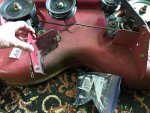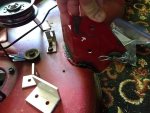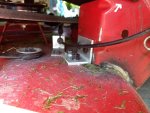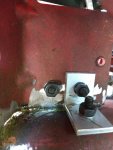turbofiat124
Well-Known Member
- Joined
- Mar 23, 2011
- Threads
- 83
- Messages
- 288
1999 Husqvarna built/ Sears Craftsman with a 46" deck. I can't remember the model number but can get it. It's out in my storage building and it's pouring down rain at the moment.
A few years ago I came too close to something and broke the weld on the left hand deck hanger. I welded it back and it held for about 5 or 6 more years until the other day I came too close to my storage building and cracked the weld once again!
Since I welded next to and on top of the old welds, I can't really tell exactly where the original location where this bracket needs to go back on. I did try to hold it on and mark it but couldn't really tell much.
I took the bracket into work and got out a massive 6" grinder and trimmed all the old welds off the bracket. I still need to grind the old welds off the deck and fill in the large crack.
When holding the bracket up the deck, it doesn't seem to jive. I tried not to grind into the bracket itself. Just the welds.
This time I decided instead of welding it on like the factory did, I found some metal off the rack at work and made some aluminum L-brackets and drilled some 5/16" holes through them. The idea is to place one bracket on one side of the steel hanger bracket and one on the other and line the holes up and run a bolt through both the hanger bracket and these L brackets. And bolt these L brackets to the deck.
The theory is five 5/16" bolts should be stronger than a weld. And if I do hit something hard again, my theory is the aluminum brackets may break before the bracket does. Allot easier to just make new brackets and bolt them on.
So here is my request.
Does anybody have one of these mowers or a 46" deck like mine laying around (early 2000s) they can measure the distance from one hanger bracket to another at both ends?
Any chance Husqvarna has not made a design change in their decks and I can just go up to Lowes with my tape measure and measure the distance from one hanger bracket to another?
The other option is to bolt the deck on, attach the other hanger to the hanger bracket, shim up the deck on the broken side and see where the hanger bracket sits on the deck and mark it. Then pull the deck back off and drill the holes. Kind of a pain but if I had measurements that would save me some time.
Seems like there is enough play in the hanger brackets I can make some adjustments if necessary if I don't get it mounted exactly where it was. Like using a longer bolt, flat washers, etc. Since the deck is not "ridged' and just floats around if you know what I mean.
I think the main thing is the deck is level. I was afraid if the deck ends up being cock-eyed, it could through the belt off.
But kind of doubt it.
A few years ago I came too close to something and broke the weld on the left hand deck hanger. I welded it back and it held for about 5 or 6 more years until the other day I came too close to my storage building and cracked the weld once again!
Since I welded next to and on top of the old welds, I can't really tell exactly where the original location where this bracket needs to go back on. I did try to hold it on and mark it but couldn't really tell much.
I took the bracket into work and got out a massive 6" grinder and trimmed all the old welds off the bracket. I still need to grind the old welds off the deck and fill in the large crack.
When holding the bracket up the deck, it doesn't seem to jive. I tried not to grind into the bracket itself. Just the welds.
This time I decided instead of welding it on like the factory did, I found some metal off the rack at work and made some aluminum L-brackets and drilled some 5/16" holes through them. The idea is to place one bracket on one side of the steel hanger bracket and one on the other and line the holes up and run a bolt through both the hanger bracket and these L brackets. And bolt these L brackets to the deck.
The theory is five 5/16" bolts should be stronger than a weld. And if I do hit something hard again, my theory is the aluminum brackets may break before the bracket does. Allot easier to just make new brackets and bolt them on.
So here is my request.
Does anybody have one of these mowers or a 46" deck like mine laying around (early 2000s) they can measure the distance from one hanger bracket to another at both ends?
Any chance Husqvarna has not made a design change in their decks and I can just go up to Lowes with my tape measure and measure the distance from one hanger bracket to another?
The other option is to bolt the deck on, attach the other hanger to the hanger bracket, shim up the deck on the broken side and see where the hanger bracket sits on the deck and mark it. Then pull the deck back off and drill the holes. Kind of a pain but if I had measurements that would save me some time.
Seems like there is enough play in the hanger brackets I can make some adjustments if necessary if I don't get it mounted exactly where it was. Like using a longer bolt, flat washers, etc. Since the deck is not "ridged' and just floats around if you know what I mean.
I think the main thing is the deck is level. I was afraid if the deck ends up being cock-eyed, it could through the belt off.
But kind of doubt it.




